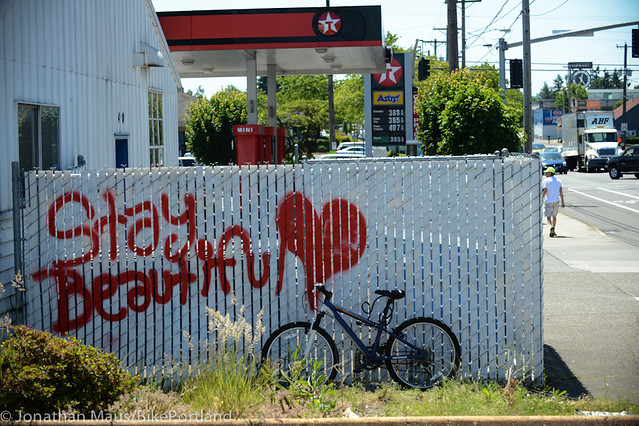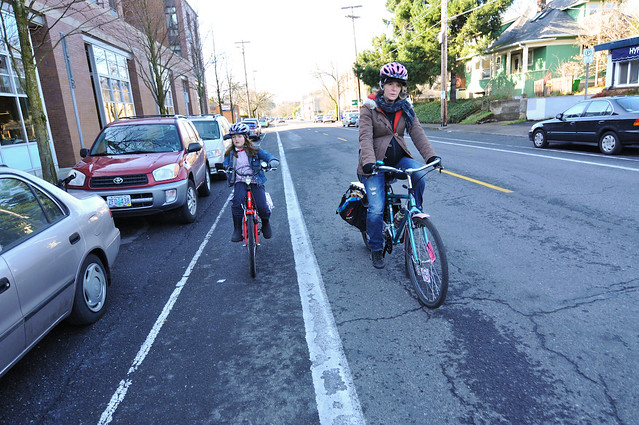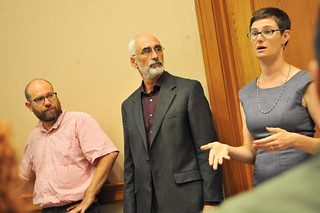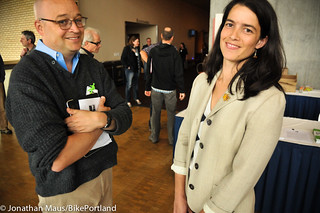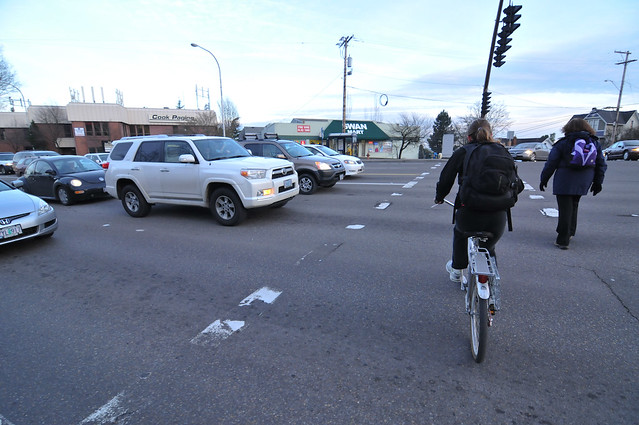
(Photos: J.Maus/BikePortland)
The debate is familiar. But lately, we’ve been hearing an interesting twist to this story: there might actually be a way to resolve it.
Portland is getting ready for a burst of its biggest biking investments in years, and it’s prompted a creative proposal for confronting one of the stickiest issues in local politics.
The city is preparing to put $6 million toward its first high-quality downtown bike lane network. Next year, a $5.2 million upgrade of Foster Road will make that highway-style street much safer to walk, bike and drive on between SE 52nd and SE 90th. Another $4.2 million will create a 130s Greenway; another greenway running east from Gateway Transit Center; and bike facilities on Division Street as far east as 130th. The $2.4 million 20s Bikeway Project is being built piece by piece.
As those investments (all of them set in motion during the Sam Adams administration but followed through on by Mayor Charlie Hales and Commissioner Steve Novick) get close to reality, they’re leading naturally to maybe the most fundamental dilemma in Portland biking.
How much should we spend to make good neighborhoods great, and how much should we spend to make bad neighborhoods decent?
Portland’s eternal question
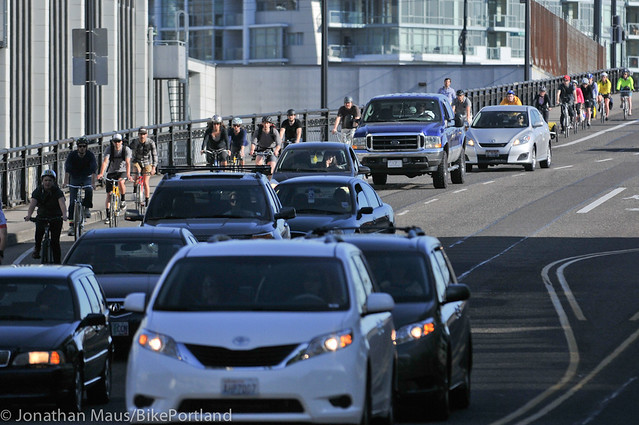
Similar questions came to a point last week when car2go said it was about to cut service to east-central Portland and St. Johns. And last month, we heard the latest hint of the discussion as it relates to bikes.
It came in a brief exchange on Oregon Public Broadcasting’s Think Out Loud program. Host Dave Miller had two guests, Roberta Robles of BikeLoudPDX and Art Pearce of the Portland Bureau of Transportation. They had this to say:
Roberta Robles: Focusing in on downtown — while it’s helpful, we need infrastructure facilities out in northeast Portland as well. Downtown is great and all, but these outer burbs, they need help getting to the grocery store, getting to their schools.
Art Pearce: I totally agree. Foster Road is a $5.2 million project that’s coming up into design next year. East Portland Active Transportation to Transit, $4.2 million starts next year. We’re starting an East Portland Fund, $9 million. There’s a whole number of projects that are happening in Portland as well. The Central City project is just one piece of a larger package of investments the city is making.
Note that the two aren’t disagreeing. Both say that improvements are needed in all parts of the city. But they’re both acknowledging how hard it is to balance two different values:
- improving downtown streets, which would probably result in a bigger jump to Portland’s bike-commuting rate
- improving further-out streets, which would probably have a benefit to more people who get around without cars
The debate is familiar. But lately, we’ve been hearing an interesting twist to this story: there might actually be a way to resolve it.
The approach comes from another field that Portlanders tend to think about a lot: public transportation.
The ridership-coverage tradeoff
It’s best described by Jarrett Walker, a transit writer and consultant who grew up in Portland and lives here today. He calls it the ridership-coverage tradeoff.
Here is Walker’s key principle: you cannot simultaneously prioritize ridership on a transportation system and the expansion of that transportation system to serve all areas.
In the world of buses: You could spend $1 million a year to make the No. 6 bus come every 5 minutes, and you’d get lots of new ridership. Or you could spend $1 million a year to provide weekend and late-night bus service every 30 minutes to parts of Sherwood, Estacada and Forest Grove, and you’d be serving a relatively small number of people who would benefit greatly from the service.
When Walker advises public transit agencies on how to divvy up their money, he tells their leaders this: make a choice. Choose a percentage of any new money that will go toward maximizing coverage and a percentage that will go toward maximizing ridership.
Advertisement
Michelle Poyourow, a longtime Portland bicycling advocate who works as a senior planner for Jarrett Walker and Associates, said Portland’s bicycle network choices face the same tradeoff.
“You spend a million dollars on a bikeway, and you get thousands and thousands of people using it in one place,” she said. “You spend a million dollars on a bikeway in another place and you get hundreds of people using it. Which is the right place? Well, it depends on whether you value ridership or coverage. There’s no correct answer to that question.”
‘A resilient plan doesn’t just say yes to everyone’
Jessica Roberts, a Portland-based principal at Alta Planning + Design who follows Walker’s work, suggested during a public forum last fall that Portland could defuse some of the endless debate between these two values by setting a percentage — maybe 70-30, or maybe 50-50 — to allocate new spending on its biking network.
“Because we have nothing more than the change behind the couch cushions to work on bike projects, I think we’re seeing a lot of tension between I guess what you might call equity-based arguments and people who want to see us direct our resources to the parts of our city where we already have people biking,” Roberts said in an interview. “You’re both right! … You don’t really have to choose only one or only the other, but it behooves transit agencies and especially transit agency boards to have a really explicit conversation about why they run their transit system, what their goals and objectives are.
“I can’t help but wonder if a similar conversation can’t happen in the bikeway realm,” Roberts said.
Poyourow and Roberts acknowledged that the usual assumptions of mass transit — that service to dense, walkable parts of a city will usually tend to have the most ridership payoff — might be more complicated when it comes to bicycling.
But both consultants said it’d be useful for Portland’s biking policymakers to start thinking explicitly about the two opposing values.
“That is an idea that Jarrett developed after years and years of working with transit agencies and … after watching them get beat up no matter what they did, he said here’s a way that electeds and public officials can give really clear guidance to staff,” Poyourow said. “The first step to that conversation is admitting that those goals are in conflict, not trying to tell people that you can be everything to everyone. … A resilient plan doesn’t just say yes to everyone.”
After all, Roberts said, the choices between these tradeoffs are being made today — just not systematically.
“We negotiate these tradeoffs whether we do it in a smart informed high-level way or in really dirty politics,” Roberts said. “These decisions get made, and they will even if we have more money. so I guess the question is, is the way we’re making these decisions the best way to align our investments with our goals? Probably not. Would a ridership vs. coverage high-level conversation help? I don’t know. But it would be an experiment worth trying.”


